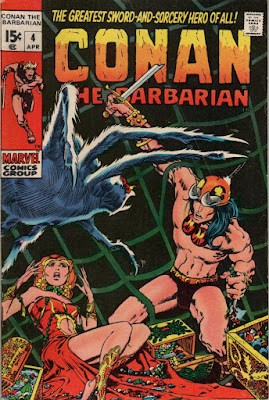The Tower of the Elephant (#4)
Analysis of Conan the Barbarian #4: The Tower of the Elephant
This issue, adapted from Robert E. Howard’s original Conan short story, exemplifies several key themes central to Conan’s narrative and the sword-and-sorcery genre: the collision of barbarism and civilization, the hero's confrontation with the supernatural, and the pursuit of glory and riches. Below is a detailed breakdown of the text, analyzing its literary and thematic significance.
1. The Setting: The Thief City of Zamora
The opening pages describe Arenjun as a decadent, chaotic city teeming with danger and vice, emblematic of the "civilization" that Conan both critiques and defies. The juxtaposition between the raucous revelry of the thieves’ den and the ethereal majesty of the Tower of the Elephant sets up a dichotomy of earthy human corruption versus lofty, otherworldly power.
- Imagery: The murky torches, shrill laughter, and gleaming tower contrast vividly, emphasizing Conan’s inevitable journey from the debauchery below to the mystical unknown above.
- Thematic Setup: Zamora’s thieves embody a corrupt sophistication that Conan, with his direct and unyielding nature, openly challenges. His disdain for their cowardice foreshadows his eventual triumph over both mortal and supernatural adversaries.
2. Conan as the Outsider
Conan’s interaction with Kothian and the thieves underscores his position as an outsider—both culturally and morally. His blunt courage and physical dominance contrast sharply with the thieves’ arrogance and deceit.
- Dialogue: Conan’s simple declaration, "There is always a way if the desire be coupled with courage," highlights his defining ethos. This line crystallizes the Cimmerian ideal of action and determination over caution and cynicism.
- Clash of Values: Kothian’s mockery and eventual attack on Conan reveal the decadence and moral bankruptcy of Zamorian civilization, which values cunning over honor. Conan’s swift retaliation embodies the brutal justice of the barbarian code.
3. The Supernatural and the Unknown
As Conan approaches the Tower, the tone shifts to one of foreboding. Yara’s ominous presence and the Tower’s mysterious aura deepen the narrative’s mythic quality.
- Symbolism of Yara: The high priest, who defies natural laws by floating above the ground, represents the hubris of civilization’s arcane knowledge. His association with the Heart of the Elephant—a gem of immense power—reflects themes of corruption through forbidden knowledge.
- Supernatural Fear: Conan’s instinctual unease at Yara’s presence highlights his primal connection to the natural world and contrasts with the more detached, intellectual approach of "civilized" sorcerers like Yara.
4. The Garden: Nature and Death
The garden’s tranquil appearance belies its lurking dangers, from silent lions to the monstrous spider above. This setting reinforces the idea that even beauty in civilization conceals deadly threats.
- Taurus and the Black Lotus: Taurus of Nemedia, the self-proclaimed "Prince of Thieves," introduces an ironic touch of camaraderie. Yet his reliance on the rare and mystical black lotus underscores his dependence on tools and tricks rather than raw courage.
- Conan’s Victory Over the Lion: While Taurus relies on poison, Conan’s visceral combat with the lion showcases his reliance on instinct and strength—a recurring theme in Howard’s work.
5. The Tower’s Inner Chamber: Encounter with Yag-Kosha
The climax introduces Yag-Kosha, the alien entity who serves as the story’s moral and thematic pivot.
- Moral Complexity: Conan’s pity for Yag-Kosha contrasts with the disdain he holds for human civilization’s corruption. This moment reveals the barbarian’s innate sense of justice, even for beings beyond his comprehension.
- Cosmic Horror: Yag-Kosha’s origin story expands the narrative’s scope, introducing themes of cosmic insignificance. The creature’s torment at the hands of Yara critiques the excesses of civilization’s ambition and cruelty.
- Themes of Redemption: Conan’s willingness to aid Yag-Kosha transforms the narrative from a simple heist into a tale of liberation and retribution.
6. The Elephant’s Heart and the Cyclical Nature of Power
The titular gem, the Heart of the Elephant, symbolizes ultimate power corrupted by greed and hubris. By enabling Yag-Kosha’s revenge, Conan inadvertently disrupts the Tower’s power structure, perpetuating the cycle of rise and fall inherent in Howard’s world.
- Irony of Wealth: Though jewels and treasure abound, Conan is uninterested in hoarding them for their own sake, prioritizing freedom and action over material gain.
- Justice Through Strength: The ultimate destruction of Yara and the Tower by Yag-Kosha’s power reinforces the barbarian ethos: might tempered by honor triumphs over decadence and cruelty.
Conclusion: Heroism and the Barbarian Ideal
"The Tower of the Elephant" encapsulates Conan’s defining characteristics: his physical prowess, moral clarity, and adaptability. The narrative critiques both civilization’s decadence and humanity’s arrogance in the face of cosmic forces.
Howard’s text, as adapted in the comic, blends action, philosophy, and horror into a compelling tale that remains one of Conan’s quintessential adventures. It’s a powerful meditation on the clash between barbarism and civilization, the allure and danger of the unknown, and the enduring power of individual courage.






Comments
Post a Comment